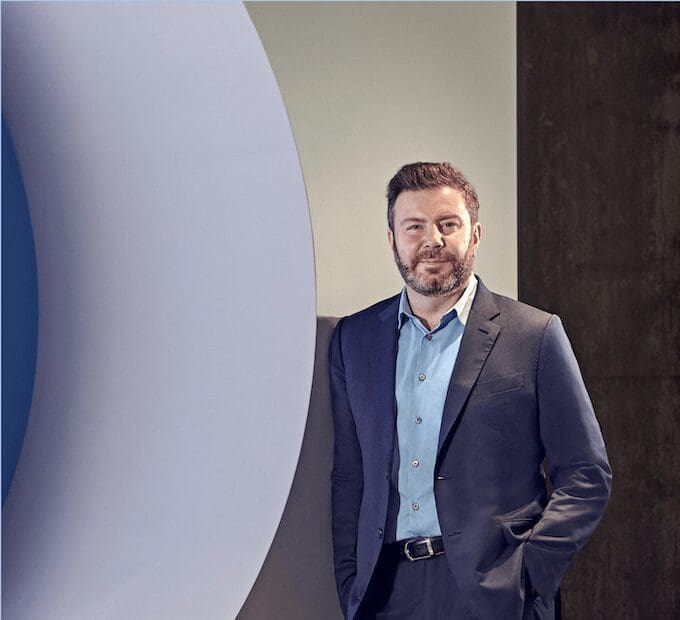The man who at once epitomizes the hottest new growth area in tech and the burgeoning hopes for entrepreneurship in Eastern Europe twirls a marker through his fingers as he fights the mundane urge to bark at his employees. Instead, Daniel Dines, the cofounder and CEO of UiPath, merely scowls at the digital whiteboard ahead of an October product release. One feature raises security concerns; another hasn’t been designed properly for mobile.
Finally, Dines, a Microsoft veteran who pines for the simplicity of the Windows bottom-left start button, can no longer contain himself. Looking over central Bucharest, Romania, where he hatched UiPath, Dines rousts a product executive in Bellevue, Washington, where it’s 6:30 a.m. “I want you to rethink this,” Dines says. “This feels very complicated to me. It should work like Gmail works.”
Interface is crucially important to Dines because his ultimate product is something invisible to the human eye. UiPath creates bots—blocks of code that automatically carry out repetitive tasks. You might associate bots with Russian election ruses or customer service stand-ins, but UiPath recently garnered a $7 billion valuation by selling a more humdrum kind that can pull numbers from invoiced PDFs into accounting software, or process insurance claims—the mindless tasks that, like those of bank tellers or telephone operators generations ago, cry out to go the way of the dodo.
This shift—which has spawned an entirely new tech category, known as “robotic process automation,” or RPA—carries eye-popping potential. Japan’s Sumitomo Mitsui bank group, a UiPath customer since April 2017, projects that reducing employee busywork and improving accuracy will have saved it nearly $500 million by next year. Giants like Toyota and Walmart have flocked to UiPath for similar magic. Setting up virtual robots is faster and cheaper than assigning engineers to build an internal app, and it spares workers the low-tech alternative: long hours creating Excel macros and filling spreadsheets. A UiPath bot does the task endlessly, without complaint, for up to $15,000 a year. Some companies use thousands at a time.
Dines, 47, didn’t invent RPA, but he’s adroitly positioned himself to dominate it. Two years ago, when European investors valued it at $110 million, UiPath was a little-known company of 150 based in Romania that had just booked less than $5 million in revenue. Today it’s headquartered in a gleaming skyscraper on Park Avenue in Manhattan and employs 3,200 in more than 30 offices around the world. It generated $155 million in revenue last year and expects to double that this year. The shift has shot it to No. 3 on Forbes’ 2019 Cloud 100. In April, Wall Street investors including Wellington Management pumped in $568 million, at a valuation of $7 billion, making Dines, who owns more than 20%, the world’s first bot billionaire.
He won’t be the last. With bots poised to create vast efficiencies via artificial intelligence (rather than just, say, generate fake pro-Trump Twitter accounts), a land grab is emerging. Blue Prism, listed on the London Stock Exchange and the category’s creator, recently raised $130 million by issuing new stock. SoftBank has invested $300 million in San Jose, California-based Automation Anywhere, which claims to be beating UiPath in artificial intelligence. And tech’s cloud giants—led by Microsoft—are showing signs of elbowing in.
Thus Dines’ impatience in Bucharest. UiPath must continue to push the limits of how fast a startup can grow without collapsing on itself and simultaneously serve as the face of an “industry” tarred by the risks associated with malevolent bots and the prospect of lower-skilled workers losing jobs. For Dines, who has never told his story in full until now, such talk seems too familiar, akin to the swipes people took at his old boss as software emerged as a societal game-changer. “Bill Gates used to talk at Microsoft about a computer in every home,” Dines says. “I want a robot for every person.”
“Humility” is one of UiPath’s four main tenets, akin to Google’s early maxim “Don’t be evil,” and it’s practiced just as inconsistently. At lunch with Dines in Bucharest, the founder says he doesn’t consider himself a great coder, just a very good one. By dinnertime, he says he’s still better than anyone at UiPath.

Whichever Dines you believe, programming launched him out of Romania. The son of a teacher and a civil engineer who met after both were relocated by the government of dictator Nicolae Ceausescu to a new chemical factory town, Dines grew up behind the Iron Curtain wanting to be an author, only to discover he was far better at math. He started college in 1990, a year after the Berlin Wall fell and Ceausescu’s regime ended in front of a firing squad. Bored with impersonal lectures, Dines skipped all but some math and computer science classes to play competitive bridge. He supported himself as a post-Communist arbitrager of Romania’s inflationary currency, buying goods when they were cheaper in Bucharest and sending them home with a markup.
While running a jobs listings business in the mid-’90s, Dines heard that coders in Bucharest working on outsourced projects for U.S. tech companies were making a relatively princely $300 a month. He borrowed a book on C++ from the library and taught himself, using a friend’s computer while he slept. By 2001, he had an offer from Microsoft and moved to Seattle, where he worked as a programmer for nearly five years. “My first years were terrible,” Dines says. “In meetings, I understood 50% to 60% of what they talked about, and I couldn’t speak anything.” It was only much later that he discovered that some words—like “folder”—were more than the names of Windows icons.
In 2005, he returned to Bucharest to start a tech outsourcing company, DeskOver. In keeping with the times, Dines had forsworn bridge for poker, where his management style emerged.
“He took a lot of risks, so most of the time he would lose, but he liked to make a learning experience out of it,”
says Marius Tîrca, who emerged as Dines’ chief lieutenant.
“He’d play sometimes with the cards on their face and ask everyone how they would play his hand.”
Those lessons were put to the test after he lost his largest outsourcing customer in 2011. Rather than fold up his little shop, he quit chain-smoking and elevated Tîrca to cofounder and, later, chief technology officer—and they focused on the company’s side business selling software development kits, or SDKs, that helped engineers code apps faster. That proved to be a stopgap. The fundamental shift came when an Indian customer showed Dines how it was building off those tools to train software to mimic basic tasks like data entry, no engineer needed.

UiPath dispatched staff to visit the Indian company and then, it says, snatched the contract from Blue Prism, which had just coined the term “RPA” after automating back-office functions for banks. “They made it clear this was the best use of our technology,” Dines says. “Our software was completely useful in the RPA world.”
So Dines went into the virtual robot business, focusing on software programs that ran autonomously without requiring the writing of new code. By 2014, the company had $500,000 in revenue—not bad in Romania —and Dines, inspired by Hacker News message boards, targeted bigger customers and Silicon Valley-style scale. He shifted the business model to software-as-a-service subscriptions, raised $1.6 million from European funds Earlybird, Credo Ventures and Seedcamp, and hastily renamed the company UiPath, after a technical term in the startup’s code.
Instead of competing with the big auditing and consulting firms, UiPath became their partner. Companies like Cognizant and EY already had deals with multinationals to make processes like procurement more efficient. As UiPath customers themselves, they could save money per client by automating some of that work. More lucrative: Dines would encourage consultants to introduce UiPath to their clients by letting the consultants keep as much as 80% of the overall bot-related spend in exchange for setting up and maintaining the program. Suddenly some of the world’s biggest companies were serving as little UiPath’s sales force. In fact, it would be two years before Dines met any of his customers face to face (Swiss Re insisted Dines fly to Zurich for a $100,000 contract).
As rival Blue Prism went public in 2016 (current market cap: $750 million), Dines was determined to take UiPath global. He had already scored U.S. clients, like a $300,000 contract with General Electric, over the phone. But Dines knew that for bigger deals he’d need boots on the ground, first with an office in outsourcing hub Bangalore in 2016, then London and New York. By Valentine’s Day the next year, Dines had signed the term sheet for $30 million in investment at a $110 million valuation from Accel as executives waited at the airport to go open the Tokyo office. Dines had a parting shot for Accel’s London investors before jetting off. “Daniel looks at us and says, ‘I will make you guys a lot of money!’” Accel partner Luciana Lixandru says.
Funding secured and aspirations multiplied, Dines relocated his headquarters—and his family—to New York two years ago. (He still spends about a third of his time working out of the Bucharest office, now an R&D center.) By the end of 2017, UiPath had just over $30 million in revenue, and unlike typical Silicon Valley startups, which often start selling to each other, the company claims that 60% of the biggest companies in America are clients. The global focus shows: UiPath’s sales come in about equal thirds from North America, Europe and the rest of the world.
“I told Masa, you’re welcome in the company,” Dines says. “But you can only invest this much.”
This rapid, diverse growth quickly drew more blue-chip investors. Alphabet’s startup investment shop, CapitalG, joined its $153 million Series B in March 2018, which valued UiPath at $1.1 billion, with Accel returning for more.
That summer, as sales topped $100 million, Dines got the offer that has become a rite of passage for unicorn founders. Representatives of SoftBank’s Vision Fund, the $100 billion investment vehicle led by Masayoshi Son, caught up with Dines as he vacationed in France’s Côte d’Azure. Dines flew to Japan to meet with Son himself, who Dines says offered him a $1 billion investment—more dilution and board control than he was comfortable with. “I told Masa, you’re welcome in the company,” Dines says. “But you can only invest this much.” UiPath chose CapitalG and venture capital firm Sequoia to colead the $225 million investment that valued it at $3 billion. “Daniel is a brilliant negotiator. He is like a crocodile in the water,” says Mihai Faur, UiPath’s chief accounting officer, who worked on the funding rounds. “He’s relaxed on the outside. Inside, he has a fire.”
Silicon Valley’s hustle culture idolizes CEOs who rise before dawn to exercise or meditate while the rest of us punch the snooze button. Dines wakes up most mornings and reads until he’s bored, an hour or more, then takes a quick nap. Only then—11 a.m. when he’s in Romania (Dines swears he’s a bit earlier in New York)—does he deign to open WhatsApp and Slack.
A dinner conversation with Dines can zip from Hermann Hesse to Byzantine history to business how-to’s like the late Zig Ziglar’s Secrets of Closing the Sale. The Microsoft programmer who didn’t know what a folder was is now conversant about Amor Towles’ novel A Gentleman in Moscow, a bestseller on Bill Gates’ summer reading list. Dines is fascinated by how the protagonist, Count Rostov, changes his life for the better when he adopts a little girl. “The Count and I share a lot of the same personality, the same vision,” he says. “I work really hard at the company, but only at things I like. Being a lazy person, I had to build better pattern recognition in life.”
That means Dines now spends most of his time on airplanes to keep his sprawling staff on the same track. It’s not easy. With senior executives joining from HP, Microsoft and SAP, UiPath is trying to graft corporate expertise onto a startup’s ethos. Gone are the days of board meetings held over a Ping-Pong table in the local language. “It’s easier to curse in Romanian,” sighs Bogdan Ripa, the Bucharest-based head of product.

The marching orders are clear. Thirteen years ago, Amazon Web Services launched and cloud computing burst onto the scene, establishing a new hierarchy of tech titans dominating the $200 billion market while relegating others to the walking dead. RPA is trying to be next. By total dollars, the RPA market is still small—just $846 million in revenue in 2018 globally, according to Gartner—but those numbers belie much larger contract values as subscription revenues recur and businesses expand their processes over time. “Pretty much everyone has started on this journey,” says Sundara Sukavanam, head of the automation practice at Cognizant, where 2,500 specialists work on bots and customers, armed with beefy budgets to digitize their operations, spend millions for thousands of them. “RPA is the fabric of the future. Where there is a manual operation, RPA will exist.”
Toyota has automated 86 processes in North America using UiPath across manufacturing, research and development, and corporate services, saving 40,000 labor hours a year. The bots handle everything from ordering business cards to accounts receivable for the global automaker. One pulls together all the data from Toyota’s 12 major North American rail carriers into a visualization that took hundreds of hours to produce manually before. Toyota plans to automate another 60,000 hours by year-end. And that’s not counting Japan. “We’ve crawled, we’ve walked and now we are picking up to a jogging pace,” says Jason Ballard, general manager of Toyota North America.
UiPath is far from alone in benefitting. Consultancies like Deloitte work agnostically with multiple RPA providers. At Automation Anywhere, customers include Juniper Networks and Symantec as well as financial services companies like Australia and New Zealand Banking Group. CEO Mihir Shukla raised $550 million in funding last year to fend off UiPath, including $300 million from SoftBank. Shukla’s business doesn’t disclose revenue, but he boasts its sales and customer count are bigger than those of UiPath. “The product difference looks like a Nokia phone versus an iPhone,” he says. “Make no mistake, we are the largest . . . and our next round of funding will show you that.”
How Robotic Process Automation Works

UiPath and other RPA players save time and money for corporate clients by setting up software “robots” that can take over human workers’ repetitive tasks.
The front line of the automation battle remains artificial intelligence—growth comes from making bots smarter, more durable and able to handle complex work tasks. Blue Prism made a reported $100 million AI acquisition in June; Automation Anywhere says it has offered AI tools, such as one that can approve a mortgage in five minutes or less, for the past five years.
At UiPath, visitors to the company’s “center of excellence” in Bucharest experience AI demos that predict which routine functions would be ripe to hand over to bots. In October, UiPath plans to announce several AI-focused acquisitions of its own. “We are making investments in helping our customers interact with the robots,” Dines says.
The biggest tech companies have mostly played nice for now. But the lines are getting increasingly complex. Google is a UiPath customer and an indirect investor through CapitalG, and UiPath software is mostly built on top of Microsoft software and cloud hosting tools. Microsoft is an anchor investor in SoftBank’s upcoming second mega-fund, reportedly in part to work more closely with SoftBank’s portfolio companies, which now include UiPath’s closest rival. At the same time, Microsoft continues to invest in its own automation platform, Microsoft Flow, that some industry watchers see as a challenge to the RPA set.
Then there’s a potential political hot potato: whether RPA, and its promise of efficiency, comes at the cost of human jobs. Marie Myers, UiPath’s CFO, says that when she spread the use of bots across former employer HP’s accounting operations, employees willingly retrained with RPA to work on, and add more, bots. Still, such a shift means workers will need to learn new skills—including how to maintain these automated systems. “I’ve talked to many firms and asked, ‘Give us your data and we’ll evaluate whether you’re actually creating as many jobs as you’re destroying,’ ” says MIT economics professor Daron Acemoglu. “At that point, the conversation stops.”
As for UiPath, Dines says the goal is to be IPO-ready by the end of 2020, with an eye to going public in 2021. “I don’t care at all about ringing that bell. Zero. But you can’t be a really big private company,” he says. “At some point you have to be public.” Before then, UiPath could raise money again, as soon as early next year. If it does, it would fetch a far higher price, assuming it achieves its goals of $300 million in revenue by the end of this year and a run rate of $1 billion in 2020.
“UiPath isn’t a company where you can predict in six months what the company will look like, because nobody’s done this before,” Dines says. “It’s like a book: It’s constantly changing.”
Cover Photograph by Levon Biss for Forbes






















